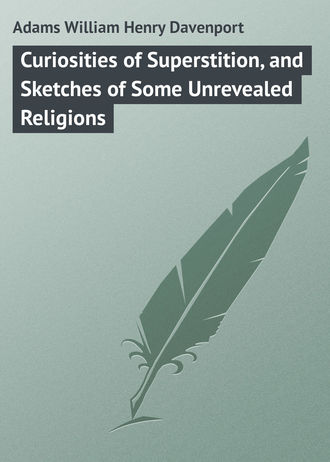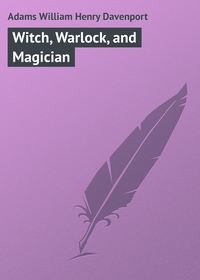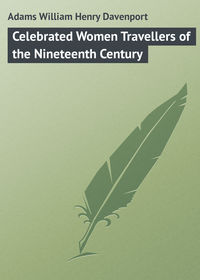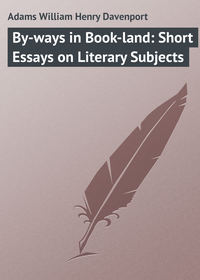 полная версия
полная версияCuriosities of Superstition, and Sketches of Some Unrevealed Religions
Mr. Fergusson remarks:50
“It is, however, not only in the Topes that this absence of dress is so conspicuous. In all the sculptures at Karli, or Ellora, or Mahavellipore, or in the paintings in Ajanta, the same peculiarity is observable. Everywhere, indeed, before the Mahometan conquest, nudity in India conveyed no sense of indecency. The wife and mother of Buddha are at times represented in this manner. The queen on her throne, the female disciples of Buddha, listening to his exhortations, and on every public occasion on which women take part in what is going on, the costume is the same. It is equally remarkable that in those days those unveiled females seem to have taken part in every public transaction and show, and to have mixed with the men as freely as women do in Europe at the present day.
“All this is the more remarkable, as in Buddhist books modesty of dress in women is frequently insisted upon. In the Dulva, for instance, a story is told of the King of Kalinga presenting to the King of Kosála (probably Padh), a piece of muslin, which afterwards fell into the hands of a lewd priestess. She, it is said, wore it in public, while it was so thin that she, notwithstanding this, appeared naked to the great scandal of all who witnessed the exhibition.51 The probability is, that the story and the book that contains it are of very much more modern date than our sculptures. It certainly is in direct conflict with their evidence.”
The want of shame in women, to which this exposure of the person bears witness, is always the mark and sign of inferior civilisation.
The other race depicted in the sculptures has its distinctive characteristics. The male costume consists of a kilt, – not a cloth wrapped round the loins, but a kilt, shaped, sewn, and fastened by buckle or string; – and also of a cloak or tippet, which seems to be similarly shaped and sewn. As for the hair, it is twisted into a long rope or plait like a Chinaman’s, and then folded round the head in a conical form, or a piece of cloth or rope was treated in this way. The beard is worn, whereas no single individual of the Hindu race, either at Sanchi or Amravati, has any trace of beard or moustache; a circumstance the more remarkable, because, according to Nearchus, the Hindus dyed their beards with various colours, so that some were red, some white, some black, others purple, some green. The female dress differs from that of the Hindus even more than the male. A striped petticoat is gathered in at the knees so as to form a neat and modest garb, and a cloak or tippet like that of the men is thrown generally over one shoulder so as to leave one breast bare, but sometimes both are covered. The head-dress is a neat and elegant turban.
Who then are these people? From the peculiarities of their costume, and their living in the woods, some authorities are inclined to regard them as priests or ascetics, though, it is to be noted, they are nowhere represented as worshipping Topes, hero-wheels, or the disc and crescent symbols (the sun and moon.) In one compartment, however, they are evidently worshipping the serpent in a fire-temple. Fergusson concludes that they were the aboriginal inhabitants of Malwa, to whom came the Hindus as conquerors or missionaries (or both?) The Topes were erected and the sculpture wrought by the conquering race, and the others are always represented as inferior and engaged in servile employments, but not as converts to Buddhism. The only act of adoration in which we see them concerned is the adoration of the five-headed Naga. Mr. Fergusson proposes to call them Dasyus, not because such a name has any local or traditional authority, but because in the Vedas and the heroic poems it seems to be applied to the aboriginal people of India as opposed to the Aryans.
Proceeding now to a consideration of the sculptures, we find that one half of those at Sanchi represent religious acts, such as the worship of the Dagoba or of Trees. Once or twice the Wheel is the object of adoration, and once the Serpent. Other bas-reliefs represent events in history, and some again are devoted to the ordinary incidents of every man’s life. Their general execution is vigorous though rude. Those at Amravati “are perhaps as near in scale of excellence to the contemporary art of the Roman empire under Constantine, as to any other that could be named; or, rather, they should be compared with the sculptures of the early Italian Renaissance, as it culminated in the hands of Ghiberti, and before the true limits between the provinces of painting and sculpture were understood.”
Let us describe an upper bas-relief which has been found on the eastern gateway.
Here the people whom Mr. Fergusson calls Dasyus are represented worshipping the five-headed Naga, or Serpent, which appears in a small hexagonal temple, raising its head over something very like an altar. In front stands a pot of fire, – probably a fire-altar, – and in spite of Mr. Fergusson’s doubts, we think both the Serpent and the Fire are connected with the old Sun-worship.52
In the foreground an old man is seated in a circular leaf-thatched hut, with, according to a frequent Indian custom, a scarf bound round his knees and loins. Behind him in the hut is suspended his upper garment, and in front a bearded senior, of his own tribe, is, to all appearance, addressing him. Near this individual stands another pot of fire, with three pairs of tongs or ladles, and a bundle of sticks to feed the flame. Close beside him we see one elephant, two buffaloes, sheep, and deer. The scene takes place in a forest. Above are trees and cocks, with monkeys and peacocks; below, a reedy marsh opens into a lake blooming with lotus-flowers and occupied by geese.
A lower bas-relief in the same gateway puts before us a very different scene:
In the centre of the upper part blooms the sacred Buddhist Tree, behind its altar, with its Chattee and garlands, occupying a position similar to that of the serpent in the other bas-relief. Two Garudas or Devas, or flying figures, present garlands, and two females, instead of griffins, approach it on either side.
In the lower part of the picture, the Inja, or chief male personage, sits enthroned upon the Naga, and is sheltered by its five-headed hood. On his right crouch three women on stools, eating and drinking, and each with her tutelary or snake behind her; and above them are a female Chaori bearer and a woman with a bottle – there are snakes behind both. On the other side are two women playing on drums, two on harps, one on a flute, and a fifth dancing, but all likewise with snakes, and all in the costume which Mr. Fergusson defines as that of the Hindus.
The worship of the Naga by the bearded Dasyus as represented in the upper bas-relief, does not occur again at Sanchi, and occurs only once at Amravati. There, however, the five-headed snake is seen very frequently in front of the dagoba, and in a position which is designed to command the worship, not only of the Dasyus, but of the whole world.
The Hindu male or chief canopied by the Naga, as shown in the lower bas-relief, occurs at least ten times at Sanchi, and must have occurred several hundred times at Amravati.
Mr. Fergusson asks, what are we to infer from these facts? Is it that the Naga, or serpent, was the god of the aborigines, whom the conquering Hindus adopted as their own deity, and pretended that it was for them he reserved his patronage and support? We must recollect that the Topes were built and the sculptures carved by Hindus, and that there is no representation of a Hindu doing honour to a snake; on the contrary, the snake always does homage to the Hindu.
Shall we conclude, then, that the Hindus were the real Naga-worshipping people, and that it was they who enforced serpent-worship on the Dasyus? A conquered people have not infrequently imposed their language, laws, and religion on their conquerors.
It is, perhaps, impossible to answer these questions: a cloud of obscurity hangs over the whole subject of Snake-worship; but we take it to have been the old and prevalent faith of the aborigines of India prior to the Aryan immigration, and we believe that the Aryans adopted it more and more generally as they mixed more and more widely with the Hindus, and their blood became less and less pure. It is not mentioned in the Vedas; there is scarcely an allusion in the Râmâyana; in the Mahâbâhrata it occupies a considerable space; it appears timidly at Sanchi in the first century of the Christian era; is triumphant at Amravati in the fourth; and might have become the dominant faith of India had it not been elbowed from its pride of place by Vishnuism and Sivaism, which took its position when it fell together with the Buddhism to which it had allied itself so closely.
We turn to the celebrated Tope at Amravati, a town situated on the river Kishna. The dimensions of the Tope are 195 feet for inside diameter of the outer circle, and 165 feet for that of the inner. The procession path is paved with slabs 13 feet long, and the inner rail is 2 feet wide. It has four gateways, and projecting about 30 feet beyond the outer rail; but these are in so dilapidated a condition that their size cannot be accurately ascertained.
These circles, or circular bas-reliefs, from the intermediate rails of the outer enclosure are thus described:
In the upper circle on the right hand side a group of Buddhist priests, in their yellow robes, may be seen worshipping. In front two supple women, such as so frequently occur in these sculptures, bend in attitudes of adoration, and on the left a chief in the ordinary Hindu costume – surrounded by the women of his family – presents his little son to the Buddha-emblem.
In the lower circle the same structural arrangements occur up to the Trisul (or emblem), but the whole is surmounted by the Chakra, or Wheel, which we know to be the symbol of Dharma or the Law. Here all the worshippers are men; it is, we are told, one of the very few scenes in these sculptures from which women are entirely excluded. Whether it was considered that the study of the Law was unsuited for women, or whether some other motive governed the designers, certain it is that, contrary to the usual rule, the whole of the worshippers are of one sex and one race. The only other noticeable peculiarity is the introduction of two antelopes, one on each side of the throne.
The second circle represents the Trisul ornament, or emblem, not on a throne, but behind an altar. The sacred feet of Buddha are depicted, but there are no relics. In the upper compartment the principal worshippers are two men with seven-headed snake-hoods, and two women with single snakes.
In the centre of the bas-relief sits the principal personage, with a nine-headed snake-hood, between two of his wives, and beyond, on both rims of the circle, stands a female figure, supporting herself by the branches of a tree. On each a young girl waits; one of these girls has a snake at the back of her head. In front are three musicians, also with snakes; and on their right a lady without a snake receives the assistance of a girl with a snake.
“This distinction,” says Mr. Fergusson, “between people with snakes and those without is most curious and perplexing. After the most attentive study I have been unable to detect any characteristic either of feature or costume by which the races can be distinguished, beyond the possession or absence of this strange adjunct. That those with snakes are the Naga people we read of, can hardly be doubted; yet they never are seen actually worshipping the snake like the Dasyus, but rather as protected by it. The snake seems their tutelary genius, watching over, perhaps inspiring them; but whether they borrowed this strange emblem from the natives of the country, or brought it with them from the north-west, are questions we are hardly yet in a position to answer satisfactorily.”
We have thus abundant evidence of the prevalence of Serpent-worship in India in “olden times;” the reader will, perhaps, be surprised to hear that it lingers still throughout the peninsula. Dr. Balfour, who had an intimate acquaintance with the habits and customs of the natives, asserts that the worship both of the sculptured form and the living creature, is general. The sculpture invariably represents the Nag or Cobra, and almost every hamlet owns its Serpent deity. Sometimes it is a single snake, with the hood spread open. Occasionally the sculptured figures are nine in number, forming the Nao Nag, which is designed to represent a parent snake and eight of its young, but the prevalent form is that of two snakes twining in the manner of the Esculapian rod of classical antiquity.
It is the opinion of some Hindus that the living snake is not worshipped as a devata, or deity, but simply reverenced in commemoration of some ancient event – possibly of some astronomical occurrences. Others, however, distinctly assert that it is worshipped as a devata. However this may be, there can be no doubt that the living snake is worshipped throughout all Southern India. On their feast days the worshippers resort to the snake’s lair, which they bedaub with vermilion streaks and patches of turmeric and of wheat flour, and close at hand they suspend garlands of flowers, strung upon white cotton thread, and laid over wooden frames. During the rainy seasons occurs the great Nagpanchanic festival, when the Hindus go in search of snakes, or have them brought to their houses by the Sanpeli, the snake-charmers who ensnare them. The snakes are then worshipped, and offerings of milk are made to them, and in almost every house figures of snakes, drawn on paper, are affixed to the walls, and worshipped. Those who visit the snakes’ abodes, or tents, plant sticks around the hole, and about and over these sticks wind white cotton thread. A bevy of Mahrathi women repair to the hût, and joining hands, wind round it in a circle five times, singing songs; after which they prostrate themselves. They pour milk into the hole; hang festoons of Chembela flowers and cucumber fruit, and sprinkle a mixture of sugar and flour.
In reference to this festival, Colonel Meadows Taylor writes: —
On this occasion, Nags or Cobras are worshipped by most of the lower classes of the people in the Dekhan, and more particularly in the Shorapore country. The ceremonies are very simple: the worshippers bathe, smear their foreheads with red colour, and in small parties, – generally families acquainted with one another, – resort to the places known to be frequented by snakes. In such places there are generally sacred stones, to which various offerings are made, and they are anointed with red colour and ground turmeric, and invocations are addressed to the local genius and to the serpents. Near the stones are placed small new earthen saucers, filled with milk; for cobras are fond of milk, and are believed to watch the ceremony, coming out of their holes and drinking the milk, even while the worshippers are near, or are lingering in the distance to see if their offerings be received. It is considered a fortunate augury for the worshippers if the snake should appear and drink. Should the snake not appear, the worshippers, after waiting awhile, return to the place next morning, to ascertain the result: if the milk have disappeared, the rite has been accepted, but not under such favourable auspices as if the reptile had come out at once. These ceremonies end with a feast.
Colonel Meadows Taylor (whose language we are partly adopting) continues: —
It is on behalf of children that Snake-worship is particularly practised; and the women and children of a family invariably accompany the male head, not only at the annual festival, but whenever a vow has been made to a Serpent Deity. The first hair shaved from a child which has passed teething, and gone through the other infantile ailments, is frequently dedicated to a Serpent. On such occasions the child is taken to the locality of the vow, the usual ceremonies are performed, and with the other offerings is included the child’s hair. In every case a feast follows, served near the spot, and the attendant Brahmins receive alms and largess.
“In the Shakti ceremonies, Pooma-elhishék, which belong, I think, to aboriginal customs, the worship of the Snake forms a portion, as emblematical of energy and wisdom. Most of these ceremonies are, however, of an inconceivably obscene and licentious character. They are not confined to the lowest classes, though rarely perhaps resorted to by Brahmins; but many of the middle class sects, of obscure origin and denomination, practise them in secret, under the strange delusion that the divine energy of nature is to be obtained thereby, with exemption from earthly troubles.
“Although Snake-worship ordinarily belongs professedly to the descendants of aboriginal tribes, yet Brahmins never or rarely pass them over, and the Nagpanchani is observed as a festival of kindly greeting and visiting between families and friends – as a day of gifts of new clothes or ornaments to wives or children, &c.
“The worship of Gram Deotas, or village divinities, is universal all over the Dekhan, and indeed I believe throughout India. These divinities have no temples nor priests. Sacrifice and oblation is made to them at sowing time and harvest, for rain or fine weather, in time of cholera, malignant fever, or other disease or pestilence. The Nag is always one of the Gram Deota, the rest being known by local names. The Gram Deota are known as heaps of stones, generally in a grove or quiet spot near every village, and are smeared some with black and others with red colour.
“Nâg is a common name both for males and females among all classes of Hindus, from Brahmins downwards to the lowest classes of Sudras and Mléchhas. Nâgo Rao, Nâgoju, &c., are common Mahratta names, as Nagappa, Nagowa, and the like are among the Canarese and Telugu population.
“No Hindu will kill a Nag or Cobra willingly. Should any one be killed within the precincts of a village, by Mahomedans or others, a piece of copper money is put into its mouth, and the body is burned with offerings to avert the evil.
“It is, perhaps, remarkable, that the Snake festival is held after the season or at the season of casting the skin, and when the Snake, addressed or worshipped, is supposed to have been purified. Some Brahmins always keep the skin of a Nag in one of their sacred books.
“In reference to the lower castes alluded to, I may mention those who practise Snake-worship with the greatest reverence: – 1, Beydars. 2, Dhungars or shepherds, Ahens or milkmen, Waddiwars or stone-masons, Khungins or rope-makers, Brinjaras and other wandering tribes, Mangs, Dhérs, and Chennars, Ramorsers, Bhils, Ghonds, and Kohs, all which I believe, with many others, to be descendants of aboriginal tribes, partly received within the pale of Hinduism.
“Lingayots, who are schismatics from Hinduism, and who deny in toto the religious supremacy of the Brahmins, are nevertheless Snake-worshippers, many of them bearing the name Nag, both male and female.
“I cannot speak of the North of India, but in the whole of the South of India, from the Nerbudda to Cape Comorin, Snake-worship is now existent.”53
CHAPTER XII.
POLYNESIAN SUPERSTITIONS
When Captain Cook first visited those beautiful islands of the South Pacific which are now included under the general name of Polynesia, he found their inhabitants given over to the lowest and coarsest idolatry. Many of their rites and ceremonies were as lewd as any practised in ancient times under the auspices of the Paphian Venus. Gradually they were brought within the influence of the missionary work of the Christian Church; and though, if we may credit the testimony of recent observers, much heathenism still prevails, and gross superstitions are still secretly nourished, there cannot be a doubt, that, on the whole, their moral condition has been materially elevated.
Among the pioneers of the Cross in these “Summer-isles of Eden” one of the most eminent and successful was the Rev. John Williams; a missionary of the true type, of an enlightened mind and broad sympathies, who, after a long career of noble labour, sealed his witness to the truth with his blood, and lives in the Gospel record as the Martyr of Erromanga. From the plain, unvarnished, and effective chronicle of his “Missionary Enterprises” we glean much interesting information respecting the idolatrous ways of the islanders, revealing their identity with the superstitions that from all times have dominated over uncivilised man. In Rarotonga as in Mexico, for instance, the gods were supposed to be propitiated by human sacrifices; and in many of the islands cannibalism existed in its most disgusting form and under the sanction of a religious ordinance.
From the chief of Aitutaki Mr. Williams obtained some curious relics of idolatry. As for example: – an idol named Te-rongo, one of the great deities, called a Kaitangata, or man-eater. The priests of this idol were supposed to be inspired by the shark.
Tangarou, the great national god of Aitutaki, and of almost all the adjacent islands. He holds the net with which he catches the spirits of men as they fly from their bodies, and a spear with which he kills them.
A rod, with snares at the end, made of the fibres of the cocoa-nut husk, with which the priest caught the spirit of the god. It was used in cases of pregnancy, when the female was ambitious that her child should be a son, and become a famous warrior. It was also employed in wartime to catch the god by his leg, to secure his influence on the side of the party performing the ceremony.
Ruanu; a chief from Raiatea, who, ages ago, sailed in a canoe from that island, and settled at Aitutaki. From him a genealogy is traced. He died at Aitutaki, and was deified as Te atua taitai tere, or the conductor of fleets.
Tanu; with his fan and other appendages; the god of thunder. The natives, when they heard a peal of thunder, were accustomed to say that this god was flying: and produced this sound by the flapping of his wings.
The Rarotongan idols were of a singular character. From their size they might have suited Swift’s nation of Brobdingnagians, for the smallest seems to have been about fifteen feet high. Each was wrought out of a piece of aito, or iron wood, about four inches in diameter, carved with a rude imitation of the human hand at one end, and with an obscene figure at the other; round it were wrapped numerous folds of native cloth, until it measured two or three yards in circumference. Near the wooden image some red feathers were strewn, and a string of small pieces of polished pearl shells was regarded as the manava, or soul of the god.
An idol, somewhat resembling a Chinese joss, was placed in the fore-part of every fishing-canoe; and prior to their departure on a fishing excursion, the boatmen aways presented it with offerings, and invoked it to grant them a successful issue.
A striking scene was that when Papeiha, a converted islander, lifted up his voice against idolatry, for the first time, among the banana-groves of Rarotonga.
The Rarotongans had assembled in great numbers at a marae, or sacred enclosure, for the purpose of making offerings of food to the gods. Many priests, pretending to be inspired, were filling the air with shouts and yells; whilst around them gathered the deluded worshippers, some with one side of their face and body blackened with charcoal; others were painted with stripes of various colours; others figured as warriors, wearing large caps adorned with white cowrie shells and birds’ feathers. Breaking into their midst, Papeiha boldly addressed them on their folly in devoting such large quantities of food to a log of wood which they had carved and decorated and called a god. This challenge was immediately accepted by one of the priests, who springing to his feet, protested that their god was a real god, and a very powerful god, and that they were that day celebrating a very sacred feast.
Papeiha replied that the day was at hand when their folly would be revealed to them by the true God Jehovah, who would make their so-called gods “fuel for the fire.” This strong declaration greatly perplexed the crowd, but they continued to listen attentively while Papeiha commented on the love of God in giving His Son to die for sinners. After he had ceased, the people asked him many questions; among others, – “Where does your God live?” He answered, that Heaven was His dwelling-place, but that both Heaven and Earth were filled with the majesty of His presence. They rejoined, in their inability to conceive of an Invisible but Omnipresent Deity; – “We cannot see Him, but ours are here before our eyes, and, if the earth was full of your God, He would surely be big enough to be seen.” “And,” said another, “why do we not run against Him?” To which Papeiha ingeniously responded: – “That the earth was full of air, but we did not run against it: that we were surrounded by light, but it did not impede our progress.”







